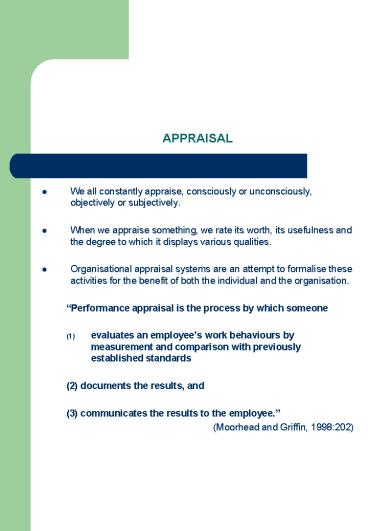APPRAISAL - PowerPoint PPT Presentation
1 / 9
Title:
APPRAISAL
Description:
indicate a number of dimensions of performance with behavioural statements ... 2. Ask for appraisee's views. 3. Appraiser offers views. 4. Explore disagreements ... – PowerPoint PPT presentation
Number of Views:75
Avg rating:3.0/5.0
Title: APPRAISAL
1
APPRAISAL
- We all constantly appraise, consciously or
unconsciously, objectively or subjectively. - When we appraise something, we rate its worth,
its usefulness and the degree to which it
displays various qualities. - Organisational appraisal systems are an attempt
to formalise these activities for the benefit of
both the individual and the organisation. - Performance appraisal is the process by which
someone - evaluates an employees work behaviours by
measurement and comparison with previously
established standards - (2) documents the results, and
- (3) communicates the results to the employee.
- (Moorhead and Griffin, 1998202)
2
USES OF APPRAISAL
- Appraisal can be used to-
- improve current performance
- provide feedback on performance
- increase motivation
- identify training and development needs
- determine the effectiveness of training and
development programmes - identify potential
- let individuals know what is expected of them
- focus on career development
- award salary increases
- solve job problems
- set out job objectives
- provide information for human resource planning
and career succession - assess the effectiveness of the selection process
- a reward or punishment in itself.
3
THREE CATEGORIES OF USES OF APPRAISAL (Randell
et al, 1984)
- Randell et al (1984) argue that the uses of
appraisal can be - categorised into three broad categories and that
an appraisal - system should attempt to satisfy only one of
these. - 1. Reward Reviews
- 2. Potential Reviews
- 3. Performance Reviews
- WHO IS APPRAISED?
- traditionally those in management and supervisory
positions - more clerical and secretarial now included
- manual staff to a lesser extent
- HOW OFTEN?
- majority of schemes involve annual appraisal
- frequency should be related to the nature of the
organisation, the purpose and objectives of the
scheme, and the characteristics of the staff.
4
WHO CARRIES OUT THE APPRAISAL?
- Immediate supervisor (appraisal by father or
parent) - Superiors superior - involved in either of two
different ways - countersignature to give seal of approval to
indicate that the process has been fairly and
properly carried out. - may directly carry out the appraisal -
grandfather approach to appraisal. - Member of the personnel department
- Self-appraisal
- Appraisal by peers
- Appraisal by subordinates
- Assessment centres
- 360-degree feedback
5
WHAT SHOULD BE APPRAISED?
- Appraisal systems can measure a variety of
things - personality
- behaviour or performance
- achievement of goals.
- These areas can be measured qualitatively or
quantitatively. - Rating can be structured to assist objectivity.
- One way to improve the objectivity of rating is
by avoidance of personality measures. - Appraisal schemes are most useful when they
measure behaviour and performance rather than
personality and concentrate on linking ratings to
behaviour and performance.
6
METHODS OF APPRAISAL
- PERSONALITY MEASURES
- problems with traits is that they can be defined
differently and are not mutually exclusive - may not be relevant to the appraisees job
- BEHAVIOURALLY ANCHORED RATING SCALES (BARS)
- sample group of raters suggest examples of
behaviour - examples collated and returned with no indication
of scale point for which suggested - sample raters allocate scale points to each
example - those consistently located at the same scale
point are selected - BEHAVIOURAL OBSERVATION SCALES
- alternative way of linking behaviour and ratings
- similar to BARS - indicate a number of dimensions of performance
with behavioural statements for each - individuals appraised as to the extent to which
they display each of the characteristics - MEETING OBJECTIVES
- job objectives set and measured
- appraisee involvement in setting objectives
varies - various problems with this method e.g. factors
beyond appraisees control may affect achievement
of objectives, objectives may change over year
7
DEVELOPMENT OF APPRAISAL CRITERIA
- Critical incident technique
- to identify particularly difficult problems at
work. - Content analysis of working documents and
performance questionnaires - managers and potential appraisees identify
(anonymously) what characterises the most
effective and least effective job holder. - Job analysis
- identifies appraisal criteria, and formulates key
tasks and duties and expected standards - appraisal based on a comparison between this and
actual performance - apparent validity and relates to job performance.
8
THE APPRAISAL INTERVIEW
- Purpose of the interview and extent of
appraisees participation depends on the uses of
the appraisal and extent to which it is an open
process. - Appraisal interview can serve a variety of
purposes. - Beware of dangers such as appraiser jumping to
conclusions or being badly prepared, not allowing
enough time either for the appraisee to prepare,
or for the interview itself. - Recommended Structure for a Performance Appraisal
Interview - 1. Purpose and rapport
- 2. Ask for appraisees views
- 3. Appraiser offers views
- 4. Explore disagreements
- 5. Resolve differences
- 6. Close
9
ESTABLISHING A SUCCESSFUL APPRAISAL SYSTEM
- The purpose and nature of the appraisal system
should be made clear - Commitment and support from top management
- Related to corporate objectives
- Openness and participation
- Appraisal criteria
- Training
- Administrative efficiency
- Monitoring and follow-up action
- Appeals procedure
- From appraisal to performance management
- PERFORMANCE MANAGEMENT
- Stage 1 - Definition of business role
- Stage 2 - Individual objectives/targets/goals
- Stage 3 - Individual development plan to support
target achievement - Stage 4 - Assessment - ongoing, annual, linked to
pay































